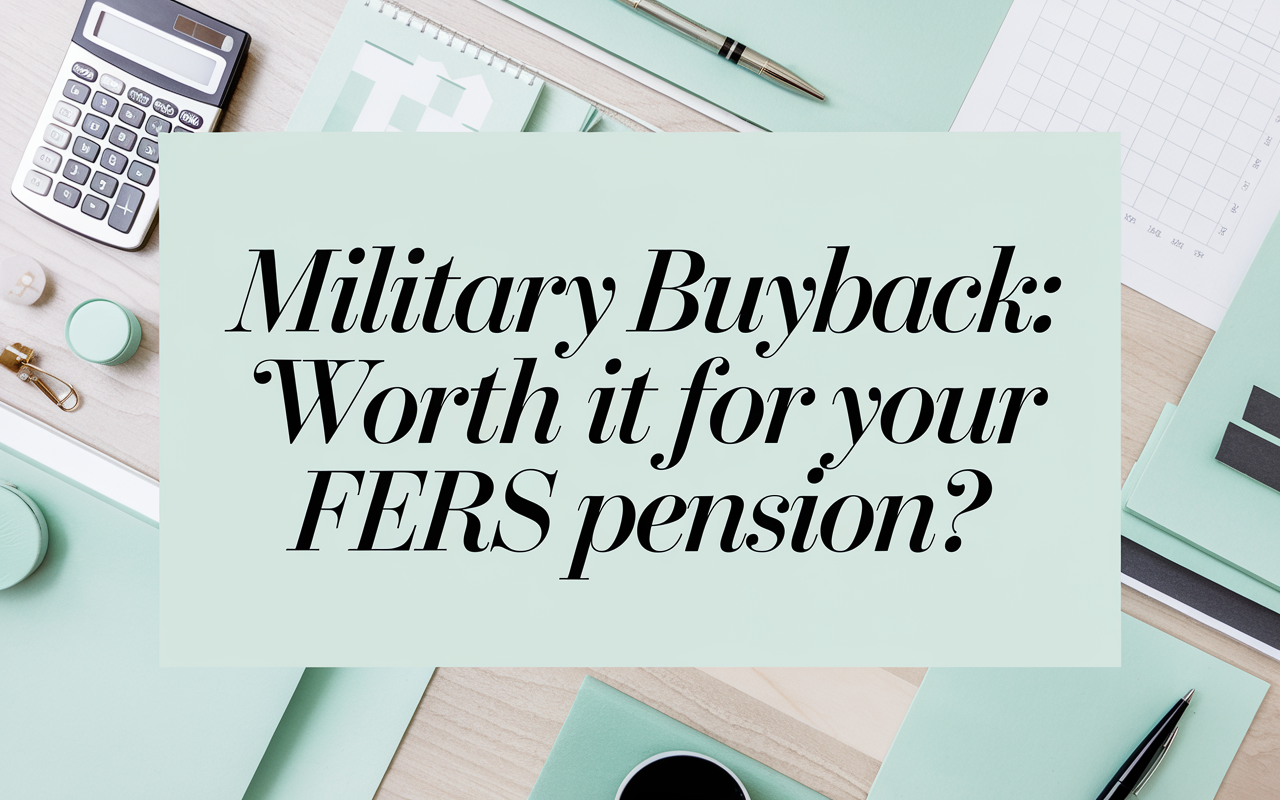Military Buyback: Is It Worth It for Your FERS Pension in 2025?
Imagine standing on the cusp of retirement after years of dedication to your country—first in military uniform, then as a federal civilian. Each step you’ve taken in your career has shaped your financial future in unique ways. Perhaps you’ve heard about military buyback and wondered whether this opportunity to convert your prior military service into additional credit toward a Federal Employees Retirement System (FERS) pension is truly worth the cost. In 2025, with changing interest rates and evolving retirement goals, making that decision can feel especially challenging. This article aims to clarify the concept of military buyback, outline the potential gains and pitfalls, and guide you toward the best strategy for your retirement.
Understanding Military Buyback
Military buyback, sometimes referred to as the Military Service Deposit program, allows federal employees who served in active-duty military positions to pay a deposit so that those years of service count toward their civilian retirement under FERS. This arrangement brings together two distinct phases of your career into one unified calculation, potentially increasing your monthly pension in retirement. Veterans often find the prospect appealing because each year of active-duty service that’s bought back may lead to higher monthly annuity checks and even earlier retirement eligibility.
The buyback process hinges on paying a deposit based on what you earned in basic pay during military service. Once you complete the deposit, you gain additional “creditable service,” the term used by the Office of Personnel Management (OPM) to describe service time that is recognized toward pension calculations. The sense of urgency surrounding 2025 largely comes down to interest rates, which affect the total cost you’ll pay for this deposit. As legislation and economic factors evolve, the calculations behind military buyback can shift, motivating many individuals to consider making timely decisions. For a closer look at the rules surrounding service credit, check out Federal Retirement: Military Service Deposit Rules for FERS Service Credit.
Calculating the Cost of Military Buyback
Understanding exactly what you’ll pay for a military buyback deposit can feel like a puzzle, so let’s break it down. For most FERS employees, the base cost is 3% of your basic military pay for service performed between 1957 and 1998, with slightly higher percentages for services in 1999 (3.25%) and 2000 (3.4%) then resuming to 3% starting in 2001. If you pay this deposit within your first three years of federal service, you typically do not owe any interest. However, if you’ve been in federal service longer than two years without paying your deposit, interest is likely to be added. By 2025, that interest rate has climbed to 4.375%, which increases your overall buyback expense the longer you delay.
For example, consider a veteran who served on active duty from 1990 through 1993. During those four years, the veteran’s basic pay added up to $61,000. The 3% deposit rate means the total cost, before interest, is $1,830. If interest applies, that total grows over time.
| Service Year | Basic Pay | Buyback Cost (3%) |
|---|---|---|
| 1990 | $13,000 | $390 |
| 1991 | $14,000 | $420 |
| 1992 | $16,000 | $480 |
| 1993 | $18,000 | $540 |
| Total | $61,000 | $1,830 |
As you can see, the upfront cost can be relatively modest compared to the potential long-term gains in your pension. However, the real question is whether that investment is worth it when future interest accrual and your retirement timeline factor in.
Benefits of Military Buyback
The most immediate advantage of buying back your military service is an increase in the number of creditable years used to calculate your FERS annuity. Under the Federal Employee Retirement System (FERS), retirees generally receive 1% of their high-3 average salary times their years of creditable service if retiring before age 62, or 1.1% if you retire at 62 or later with at least 20 years of service. This means each extra year you buy back could boost your pension by roughly 1% of your high-3 salary. For those who served several years in the military, that bump can significantly impact your monthly benefit.
Another advantage might be reaching earlier retirement eligibility. If you need 30 years of service to comfortably retire by a specific age, the extra years of military time may help you qualify for an unreduced pension sooner. For example, if you already have 25 years of federal service and also served 5 years in the military, buying back that time would bring you to 30 creditable years, allowing you to retire earlier than you would without buyback.
Beyond these two primary benefits, there’s a broader sense of integration and simplicity in consolidating your service records. Rather than having a separate military retirement or no benefit credited from military time at all, buyback merges your service into a single civilian retirement framework, which can translate into less administrative complexity in the long run.
Considerations for 2025
Thinking about whether to buy back military time in 2025 requires a fresh look at the factors unique to this moment in time. First, interest rates are on the rise, which directly impacts how much you’ll pay if you’re outside that three-year window where no interest applies. An interest rate of 4.375% means that if you’ve been a federal employee for a while, delaying the buyback while interest accumulates can get costly.
Next, 2025 may bring changes to your own life circumstances. Perhaps you’re edging closer to retirement and want to confirm that you’ll have sufficient service years for a smooth exit from federal employment. If you previously expected to work until your late 60s, the addition of your military service might allow you to retire a bit sooner—or work the same amount of time and end up with a larger pension. The buyback could also influence your decisions around the Thrift Savings Plan (TSP), as a bigger FERS annuity can affect how aggressively you draw down TSP funds.
Legislative updates are generally incremental, and as of early 2025, there have been no sweeping changes specifically targeting the military buyback process. Still, it’s wise to keep a finger on the pulse of any proposed bills. If Congress debates altering the percentages or the interest accrual rules, it could shift the outlook—so staying informed helps you anticipate and adapt to policy shifts that might affect your retirement plans.
Potential Drawbacks of Military Buyback
While the advantages of a higher annuity and earlier retirement are compelling, there are scenarios in which military buyback may not be your best move. For instance, if you already qualify for retirement and the extra year or two of service credit won’t significantly lift your monthly annuity, the cost might outweigh the benefit—especially if interest payments resize that deposit. This is particularly relevant for individuals with just a short period of military service, such as a single year or two, where the increase to their month-to-month annuity could be modest.
Another consideration involves whether you’re already receiving or plan to receive a full military pension. Generally, you cannot draw a full military retirement pay and count the same military service toward a separate FERS pension. There are exceptions, especially in cases involving a disability retirement from the military, but most often you must waive your military pension if you decide to buy back that time for FERS. Carefully weigh whether this exchange makes financial sense for your circumstances.
In addition, there’s the matter of available cash flow. Some employees choose to pay the deposit via payroll deduction, stretching it over months or years. Others pay in a lump sum if they can manage it, which could help them avoid paying ongoing interest if they’re outside the no-interest window. Either route affects your current finances, so be sure you’re comfortable with how the buyback deposit fits into your personal budget.
Case Study and Examples
To see how a buyback decision can play out, consider a fictitious scenario involving Sharon, an Air Force veteran who served for four years in the early 1990s. She joined the civilian federal workforce in 2000 and only recently discovered the option to buy back her military time. Because she has been a federal employee for more than two years, she’s facing interest on that deposit. Despite that extra cost, Sharon stands to gain four additional years of service, which would bring her total federal service to 29 years if she retires in 2025 at the age of 60.
By that point, Sharon’s high-3 average salary is $68,000. In the FERS system, if you retire at age 60 with more than 20 years of service, you often calculate your pension by multiplying each year of service by 1% of that high-3 average. Purchasing four more years of service could translate to a 4% higher annual benefit. Over a 20- or 30-year retirement span, that could amount to tens of thousands of extra dollars in annuity payments. Sharon’s decision ultimately weighs the deposit cost and accrued interest—perhaps coming to around a couple of thousand dollars—against her substantially higher pension over the long term.
Conclusion and Recommendations
Whether military buyback pays off depends heavily on individual factors, including how long you served in the military, when you plan to retire from federal service, and how quickly you can complete the deposit to minimize interest costs. In many cases, buying back even a few years of military service can significantly boost your retirement income, especially if you intend to work in federal service for many more years. For those nearing retirement, the decision becomes more nuanced, as the added annuity might not justify the expense in some scenarios.
It’s wise to begin the process by requesting an estimate of your military earnings using Form RI 20-97 and then determining how much the deposit would be under the current rates. From there, you can conduct a personalized cost-benefit analysis. You might even consider using a tool like a FERS Retirement Calculator to see how military buyback could improve your overall retirement picture. This analysis should consider not just the raw numbers in terms of how much the deposit costs but also how those additional years might make a difference in your retirement eligibility date or the percentage of your high-3 salary used to calculate your annuity.
Having a discussion with your agency’s benefits officer or a financial advisor for federal employees who specializes in federal retirement, ideally holding designations like the ChFEBC, CFP®, or AIF®, can be insightful. They can help you weigh the combination of your FERS annuity, Thrift Savings Plan distributions, and Social Security benefits so you can see the bigger picture of your potential retirement income. It’s essential to clarify any questions now to avoid future regrets.
Take the Next Step
For federal employees like you—particularly those who’ve proudly served in uniform—planning for retirement under FERS can involve some complex decisions. Military buyback is one of those decisions that can have a lasting impact on your financial well-being. Whether you decide it’s right for you or not, the key is to take a thoughtful, informed approach.
If you’d like deeper insights on the mechanics of FERS, strategies for maximizing your pension, or ways to coordinate your Thrift Savings Plan, join us for one of our free Federal Retirement Planning Workshops. You’ll get straightforward advice and practical tips to help transform your retirement outlook.
Sign up for one of our free Federal Retirement Planning Workshops










